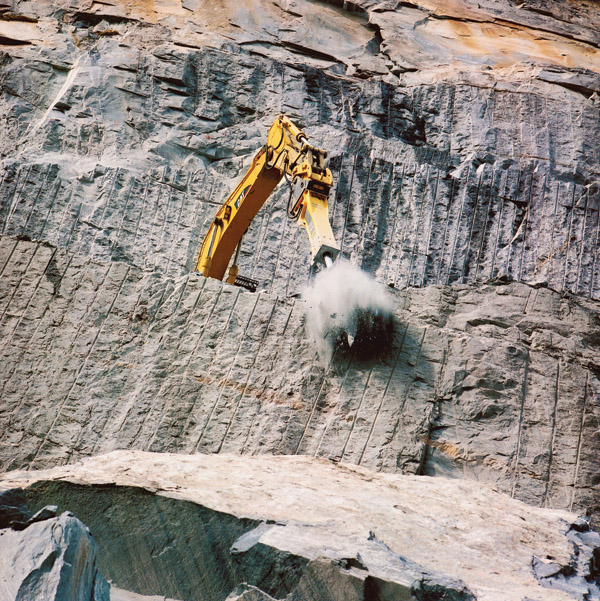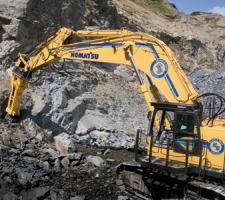
New heavyweight breakers may be hitting the headlines but it is the higher power to weight ration that is the real innovation. Claire Symes reports
Over the last few years a number of construction equipment manufacturers have unveiled new range-topping heavyweight excavators in a bid to get a slice of the quarrying market. At the same time, hydraulic breaker manufacturers have been scaling up their equipment to provide efficient tools for the growing fleets of extra-large excavators.
Nonetheless, while the operating weight of these hydraulic breakers may be setting new records, it is the power that these units deliver that is the key to their demand. Refinement to the design of the latest hammers has resulted in a leaner look with fewer parts to offer a higher power to weight ratio and greater reliability than ever before.
Launched last year,
"The idea was not to make just a bigger breaker but one that delivered the power that is needed by the aggregates market for primary breaking," explained Atlas Copco marketing manager Torsten Ahr. "The optimum weight for the HB10000 is 10tonnes to match the power of the unit with durability." But according to Ahr, its development resulted directly from the process that led to the creation of the HB7000 rather than a desire to claim the title for the largest production breaker.
"Development of the HB7000 started back in the mid 1990s before Atlas Copco merged with Krupp. The 7tonne breaker came from the Krupp arm of the business and was being driven purely by the fact that there were enough carriers in the market of the right size to use it," said Ahr. "There was no market demand for it at the time but once quarry operators became aware of the research programme, they began to ask if it was suitable for providing primary breaking.
"To put this request into context, this was around the time that environmental concerns and the proximity of residential developments were beginning to limit the use of explosives. Quarry operators needed to find an alternative to overcome these political restrictions and a new heavier, more powerful breaker was a good alternative. Also in variable deposits, the use of breakers gives the quarry operator the opportunity to be selective about the rock that is extracted." Today there are around 300 HB7000 units in the market, with around 80% used in quarries, according to Ahr.
"Following on from the success of the HB7000 we began to look at the ability to provide higher levels of production from primary breaking," said Ahr. "First we carried out a survey of the potential carriers and excavators and found that the 50 to 100tonne carrier sector was booming. Then we looked at the level of power that the newer larger excavators might be able to deliver." Atlas Copco's HB10000 was designed around delivering a higher power to weight ratio than in previous models. "The design weight is 10tonnes but compared to older designs, the weight would have to be closer to 13 or 14tonnes to deliver the same level of power." According to Ahr, there were two main technological challenges to achieving the higher power without adding to the weight. "We needed to advance our metallurgical knowledge and redefine our approach to designing a breaker," he said.
The company had to develop metals which could cope with the higher levels of stress that were likely to be created in a higher power unit. The design of the piston also needed to be readdressed to deliver a higher piston weight with reduced internal leakage, minimal clearance and with low energy loss to maximise efficiency.
"In addition the design had to deliver energy recovery from the previous stroke in order to reduce the power draw from the carrier as well as maximise the power delivery. The energy recovery was an important element because it meant the impact on the fuel efficiency of the carrier would be reduced," said Ahr.Market matters
Hydraulic breakers may be a common sight in European quarries but there is still huge potential for growth in the market, according to Ahr. Sales of extra large breakers - over 4tonnes - that are used for primary breaking currently account for just 5% of global breaker sales by volume. Even in the 1 to 4tonne bracket - the size of units generally used for secondary breaking - still only represent 15% of breaker sales, with the remainder made of units sold to the rental and construction markets. "It is over 40 years since they were first brought in to provide secondary breaking in Europe but in South America and Asia, the use of breakers for this is still uncommon, with most using secondary drill and blast or drop weights," explained Ahr. "Demand for greater productivity in these markets will drive increased demand for 1 to 4tonne breakers. As the environmental issues that are now well known in Europe start to impact on these developing markets, it is likely that a market for breakers to provide primary breaking will develop. There is also a lot more potential for primary breaking in Europe too.
"It was a technologically challenging process and the design was changed and revised lots of times during the development phase. The unit was then put through two years of field testing before it was unveiled at Bauma last year." Atlas Copco's vision that there was a market need for a more productive breaker has been borne out following its European launch with nine units now working in quarry operations.
But it is not simply a case that using a larger, more powerful breaker will result in higher production. "In the right conditions using the HB10000 can double the production capacity of the HB7000," said Ahr. "But only when used with the right rock formations - in some situations an HB7000 can give a quarry operator better efficiency. The HB10000 is better suited to very hard rock, and the higher frequency HB7000 offers higher productivity in softer rock.
"For any breaker, but particularly for these new heavy weight, higher powered units, it is essential that the rock the hammer will be used on is assessed to ensure it is suitable. The tensile and compressive strength of the rock needs to be considered along with how the breaker delivers the power to ensure maximum efficiency is achieved in the power delivery and that the actual result - the rock fragmentation - is suitable for the next process, whether it is secondary breaking or primary crushing.
"Using hydraulic breakers for primary breaking is never going to offer a quarry operator more efficiency than drilling and blasting, but it does offer them an alternative that could mean the difference between closing or being able to continue extracting aggregates."















